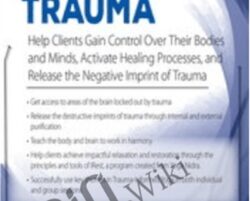The impact of trauma is so profound that it is felt not just in the mind, but in the body as well. Survivors carry the effects of the traumatic events in their tissues, negatively affecting their ability to rest, to remember and process, and to achieve a state of regulation.To successfully work with these clients, you need to utilize embodied practices that incorporate mind-body connection into your clinical practice. Mounting evidence points to yoga as a complimentary tool that you need in your arsenal to effectively work with trauma survivors.Michele Ribeiro has been using yoga and mindfulness with trauma survivors for over 20 years, and she wants to show you how to reenergize your own work. Find out how simple yoga poses and techniques can be introduced to help clients become aware of and then remove traumatic imprints through mind-body purifying processes. Teach clients how to send revitalizing, healing energy throughout their body. Discover the benefits of Yoga Nidra and how to help clients reach this state of relaxation and restoration.This recording is your “how-to” guide for incorporating evidence-based yoga poses and techniques into your practice in a manner that is effective, ethical, and appropriate for your scope of practice.You do not have to be a yoga therapist to apply what is learned in this recording to your own trauma work. You only need to have a desire to see transforming healing occur in the lives of your clients.Explain why embodiment in psychotherapy matters and how to incorporate it successfully into treatment with traumatized clients.Determine effective ways to help trauma clients focus their perception and mind on what is happening in the body as a result of the trauma.Evaluate trauma’s effects on the brain and how to use yoga to mitigate them.Apply Yoga Nidra and iRest scripts to help trauma clients achieve impactful states of relaxation and restoration.Utilize the key themes of trauma-informed yoga appropriately in both individual and group sessions.Practice various yoga postures and movements, including chair-focused trauma yoga, in preparation to use them in sessions with clients. The Promise of Yoga for Treating TraumaTrauma prevalenceAdverse childhood experiencesSocio-cultural impacts of traumaYoga research outcomes with veteransHigher retention, satisfaction and acceptability rates with yogaWhy embodiment in psychotherapy treatment mattersRisk and limitations of researchBring Traditional Yoga Components to Contemporary Trauma TreatmentThe 4 pillars and 8 limbsFocus on rejuvenating the bodyMoral and ethical conduct considerationsEstablished observances, including contentment and self-studyEmphasis on internal and external purificationAscension of energy/vitality through asana and pranayamaAbility to focus perception and mind on what is happening in the bodyBring Practical Neuroscience Applications to Contemporary Trauma TreatmentBrainwaves and patterns and their interface with yoga practicesThe Triune Brain Left and right brain functions in understanding traumaManaging anxiety with a focused attention meditation methodYoga as a Therapy ToolTeach the brain and body to work in harmonyLearn to stretch some parts of the body and relax other partsYoga’s impact on controlling the effect of the brain on the bodyDiffuse vital, healing energy throughout the bodyYoga Nidra (Changing States of Consciousness)Conscious entry into non-REM sleepIRest (Integrative Restoration)Core principles 10 tools 8, 15, and 30-minute script examples of practice sessions*Trauma-Sensitive Yoga Scripts; Physical Movements and FormsExpand capacity for self-awareness and selfregulationStanding, seated, supine, and prone postures and forms with supports*Shifting relationship with self to foster patience, internal sense of safety, a felt sense of control, and personal agencyKey themes in trauma-informed yoga for individual and group workExperiencing the present moment (example with Tadasana/Mountain pose)*Making choices (example with simple neck rolls)*Taking effective action (Example with present moment awareness and making changes)*Creating rhythms (example with cat pose/form and exploring rhythm between movement and breathing)*Chair-Focused Trauma YogaFocused meditation*Seated neck rolls/seated shoulder circles*Seated mountain*Sun breath*Seated twists*Seated forward folds*Facilitating a group therapy sessionInformed consentMatch goals with postures and formsProvide resources*Social workers: Please note that ACE credit is not available for yoga instruction/guided experience activities.Tag: Yoga for Trauma: Innovative Mind-Body Strategies that Help Clients Activate Healing Processes and Release the Negative Imprint of Trauma – Michele D. Ribeiro Review. Yoga for Trauma: Innovative Mind-Body Strategies that Help Clients Activate Healing Processes and Release the Negative Imprint of Trauma – Michele D. Ribeiro download. Yoga for Trauma: Innovative Mind-Body Strategies that Help Clients Activate Healing Processes and Release the Negative Imprint of Trauma – Michele D. Ribeiro discount.
 Copywriting Velocity Complete Virtual Program – Kim Krause
₹15,604.00
Copywriting Velocity Complete Virtual Program – Kim Krause
₹15,604.00
 The Ultimate Trading Solution – Kim Reilly
₹15,438.00
The Ultimate Trading Solution – Kim Reilly
₹15,438.00
Yoga for Trauma: Innovative Mind-Body Strategies that Help Clients Activate Healing Processes and Release the Negative Imprint of Trauma – Michele D. Ribeiro
₹6,640.00



